Proposal for Former UConn Development Slated for Public Hearing on Monday

Audio By Carbonatix
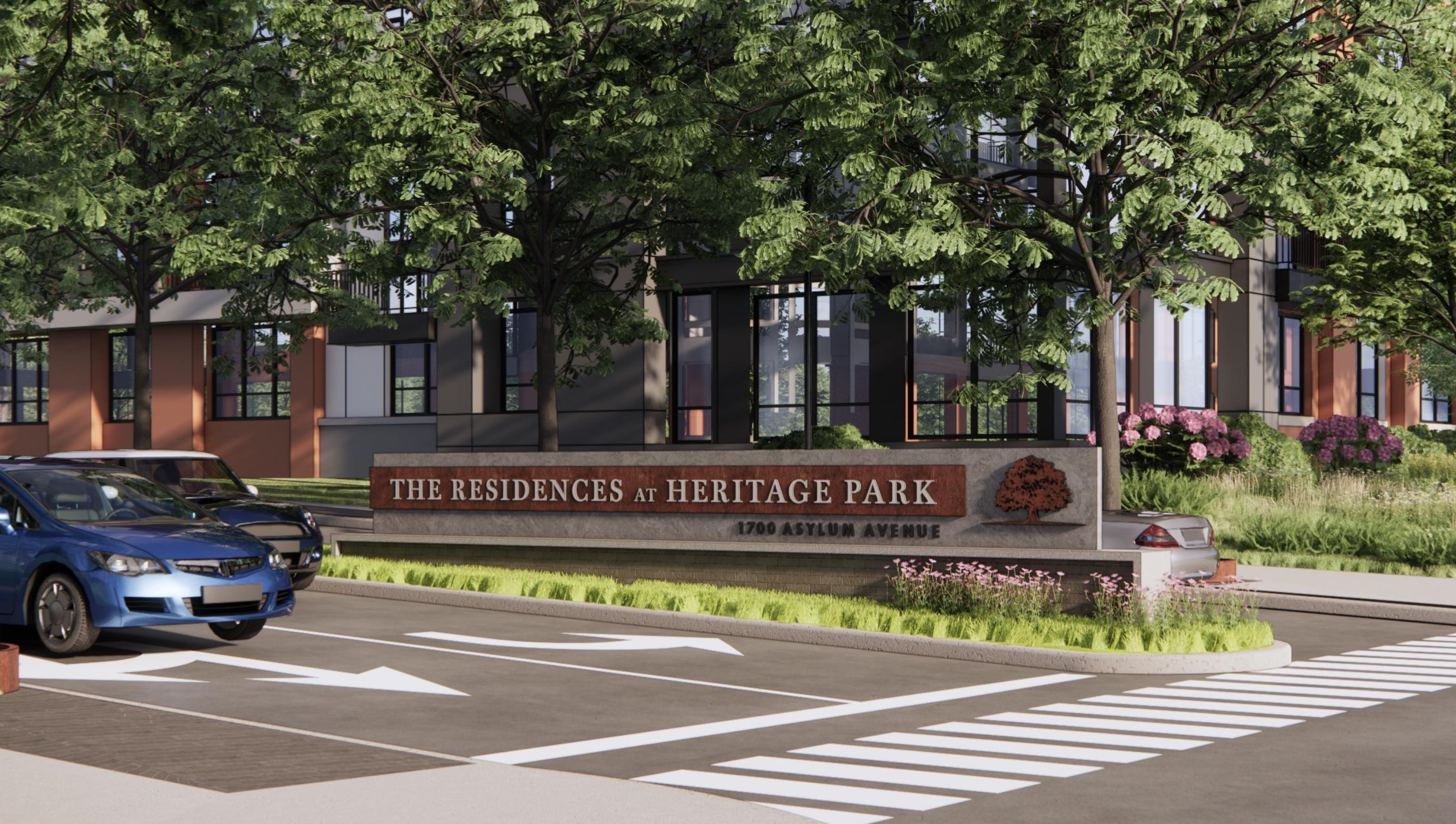
Rendering of proposed entrance to The Residences at Heritage Park – the new name of the proposed development for the former UConn campus in West Hartford. Courtesy image
The Town Council will hold a public hearing Monday, March 11, beginning at 5:30 p.m., to review the application for a zoning change and creation of a Special Development District for 1700 Asylum Avenue – the eastern portion of the former UConn West Hartford campus.
By Ronni Newton
It’s been more than two years since developer West Hartford 1 LLC purchased the entire former UConn West Hartford campus, but after receiving a wetlands permit and recommendations from both the Design Review Advisory Committee (DRAC) and Town Plan and Zoning Commission (TPZ) for the east side of the parcel, known as 1700 Asylum Avenue, on Monday, March 11, 2024, the Town Council will hold a public hearing followed by a planned meeting where they will vote on the application.
The application by WeHa Development Group East, LLC, a team led by Dominic Carpionato, was received by the Town Council at its Jan. 23, 2024 meeting, and requests approval of a change in the zoning from R-10 (single family) to RM-MS (multifamily-multistory) for the portion of 1700 Asylum Avenue where they would like to build four multifamily residential buildings of four or five stories with a total of 322 units. The area that would be subject to rezoning is 14.9 acres – the northern portion of the overall 23.8-acre parcel – most of which is currently an asphalt parking lot. The developer is also requesting creation of a Special Development District for the entire 1700 Asylum property, which would include the ballfields and playground on the southern portion of the property.
The extensive application for 1700 Asylum, which includes a nearly-700-page traffic study, stormwater management details, outreach reports, renderings, and other plan documents, is available on the town’s website as part of the agenda for the March 11 hearing.
The overall project encompasses two separate parcels of land on either side of Trout Brook Drive, requiring two separate applications to obtain wetlands permits, as well as for zoning. The wetlands application for 1700 Asylum, which had been the subject of roughly 15 hours of public hearing split into three meetings, received unanimous approval from TPZ in their capacity as the town’s Inland Westlands and Watercourses Agency (IWWA) on Jan. 17, 2024.
West Hartford 1 LLC would ultimately like to create a “neighborhood campus village” to be called Heritage Park, with the “Residences at Heritage Park” on the east side and a mix of residential and commercial uses at 1800 Asylum, which is the western portion of the property. Due to the need for further analysis of wetlands issues at 1800 Asylum Avenue, the wetlands application for that parcel was withdrawn in December and the developer has not yet resubmitted it. As was the case with 1700 Asylum, a wetlands permit is needed before the project can move to the next phase of consideration.
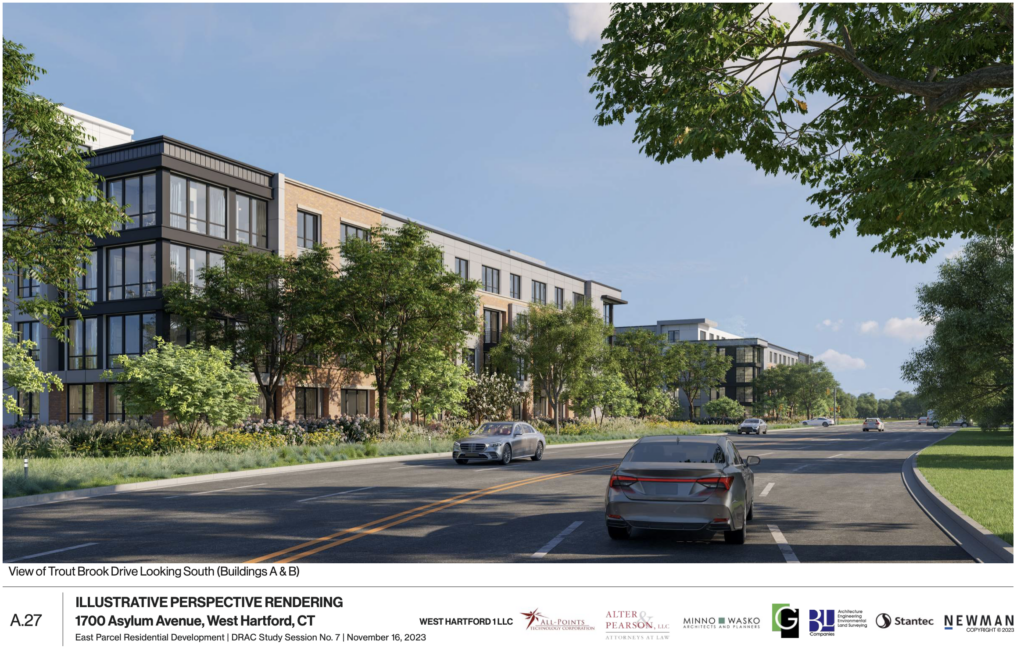
Rendering of a portion of 1700 as proposed by West Hartford 1 LLC to Design Review Advisory Committee on Nov. 16,, 2023. Town of West Hartford website image
DRAC
DRAC had conducted extensive review of the design elements of both the 1700 and 1800 Asylum parcels during seven informal study sessions, the first of which was held on Oct. 27, 2022, before giving official consideration to the 1700 Asylum application as a referral from the Town Council,
On Feb. 22, 2024, in response to the referral from the Town Council, DRAC officially considered the 1700 Asylum application and voted 3-1 to recommend approval finding the application “consistent with our Committee’s Performance Criteria.” DRAC is tasked with reviewing a proposal for site orientation, site layout, and architecture.
The approval letter specifically stated that the “relationship of the proposed buildings to the site and adjoining neighborhood is appropriate. While the collective buildings are substantial, their design, in particular site placement and architecture are compatible with its surroundings,” noting that the buildings are centralized on the site and situated as far away as possible from adjacent properties to the north and south, and also noting that the buildings along Trout Brook Drive, while five stories, have a step-back from the fourth to the fifth floor that helps reduce the perceived massing … “all of which help to create a contextually sensitive resorbs fir the redevelopment of this portion of the former UConn Campus.”
DRAC also noted the “high quality and quantity” of propose landscaping. “A good mixture of plantings ranging from street, flowering and evergreen trees to shrubs, perennials and grasses has been effectively utilized to create a well-designed streetscape and appropriately planted and screened parking areas. Of particular note is the effort to preserve the Champion White Oak and create a naturalized planting environment,” the letter states.
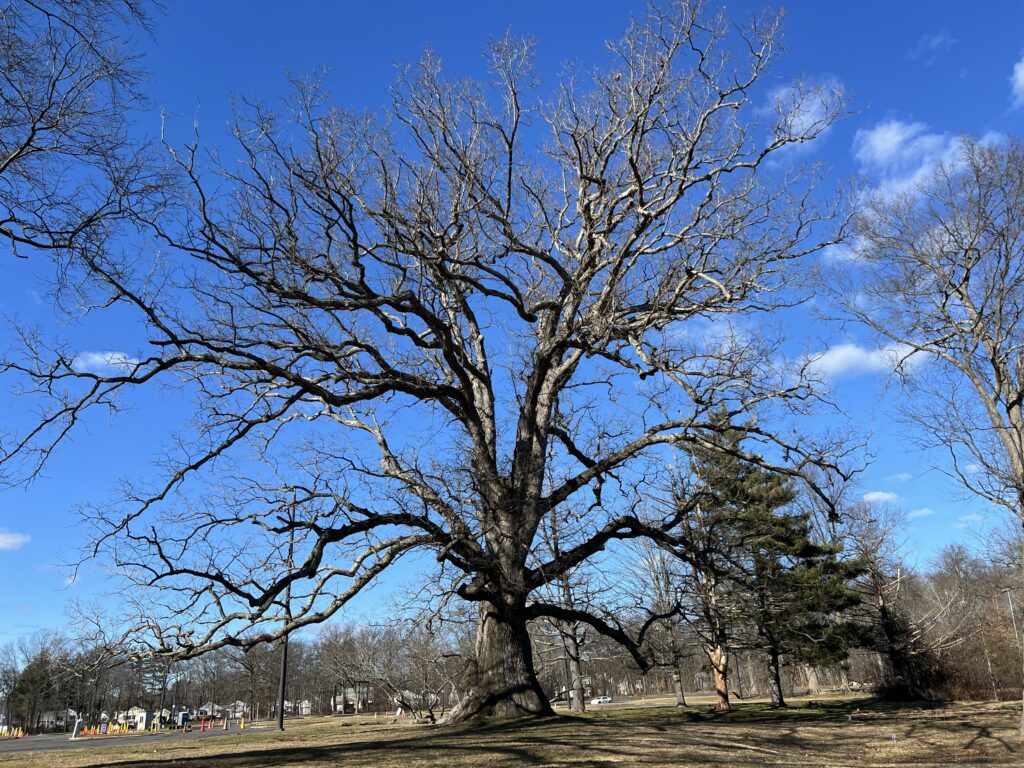
Champion White Oak at 1700 Asylum Avenue. Photo credit: Ronni Newton
DRAC noted the arrangement of landscaping and site amenities, as well as the interior trash management system, would be conducive to the long-term maintenance. Their letter did, however, suggest removal of an access-control vehicle gate that is part of the proposal because it contributes “visually and functionally to a sense of separateness and withdrawal from the surrounding community, and maintenance of the gates may create issues for residents, guests, and deliveries.”
According to Town Planner Todd Dumais, the dissenting vote by a member of DRAC mentioned the size and scale of the proposal as inappropriate for the site.
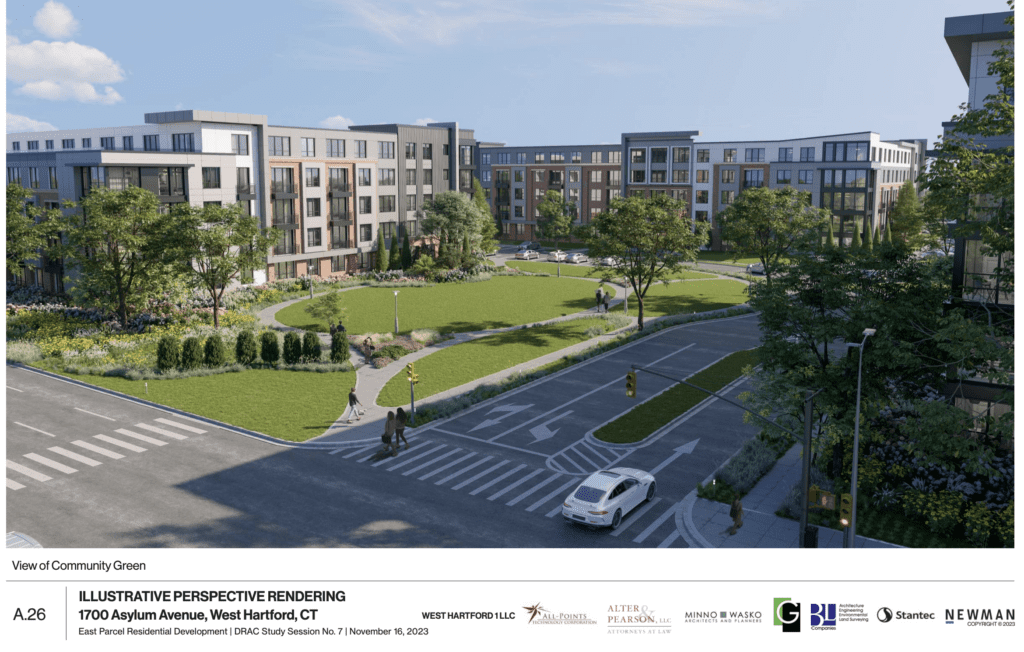
Rendering of a portion of 1700 as proposed by West Hartford 1 LLC to Design Review Advisory Committee on Nov. 16,, 2023. Town of West Hartford website image
TPZ
On March 4, TPZ officially considered the 1700 Asylum application on referral from the Town Council, and voted 4-1 to recommend the project. TPZ is tasked with considering the project in terms of the overall vision of West Hartford’s 2020-2030 Plan of Conservation and Development (POCD).
“Overall I think this has met its burden,” and fits within the POCD, said TPZ Chair Kevin Ahern before he voted to recommend the application.
The letter from TPZ noted that the proposal is consistent with the goals of the “Neighborhoods and Housing” section of the POCD, which states the goal is to: “Enhance and maintain West Hartford’s existing neighborhoods and encourage diversity of housing types and costs to provide access and availability of housing options to current and future residents” through the review and revision as necessary of zoning ordinances.
TPZ also noted that the proposal is consistent with the “Open Space and Environment” section of the POCD, which is to “preserve, protect, enhance and promote out open space and our fragile natural systems in concert with managing responsible growth and development.”
Finally, TPZ wrote in its recommendation that the proposed development is consistent with the “Land Use” section goal of the POCD, which is to “sustain and preserve the Town of West Hartford as a balanced community, maintaining and promoting neighborhood quality and open space in conjunction with the principles of Smart [Sustainable] Growth.”
During their deliberations, TPZ member Liz Gillette, who cast the dissenting vote, expressed opposition to “this type of high density, massive building structure” which she said should not be overlooked because we said we need more housing. She had asked Dumais for information about how much additional rental housing had been added since the POCD was adopted in 2020, and the data indicates about a 20% increase in rental stock. “With a 20% increase in apartments we already met that goal,” said Gillette. “I think this is just too big and not appropriate for that spot.”
TPZ member Gordon Binkhorst said he heard many of the same arguments that were raised when there was a review of the application for 243 Steele Road. “The scale of this is certainly very different from what is there now – a vacant parking lot,” he said, but he noted that the number of applications the town has recently seen for multifamily rental housing is driven by market conditions. “I do think we need additional rental units in town,” he said, but he noted – and TPZ included a recommendation in the letter – that the percentage of affordable housing should be more than 5%.
In their recommendation TPZ, like DRAC, also strongly encouraged removal of the access-control gates as “not consistent with
the vision of the POCD.”

Miracle League Field at 1700 Asylum Avenue. Photo credit: Ronni Newton
Ballfields
The southern portion of the 1700 Asylum Avenue parcel includes three ballfields and a playground, as well as a basketball court and concession area. One of the fields is the Miracle League of Connecticut accessible field, which is used not only by residents of West Hartford but also teams representing 42 towns across the state.
Over the years, nearly $1 million has been invested to create the fields, playground, welcome area, and concession building – a combination of state funds and private donations, said Mike Michaud, executive director of the Miracle League of Connecticut.
“Part of our commitment to the town when we got the permission to build [the Miracle League field] is that we would take care of maintenance,” said Michaud.
According to Michaud, more than $300,000 in funds raised by private donors has been set aside for resurfacing of the Miracle League fields, but they don’t want to begin the project without a formal agreement in place for long-term use of the fields. Under the current ownership, they have had 6-month lease agreements, which he said creates too much uncertainty to invest in resurfacing.
The ballfields seem to have been forgotten in the discussions, said Michaud, although one sticking point he mentioned is the amount of parking required for the fields. On 10 to 12 days per year, additional parking is needed beyond what is in the existing lot, and there has been discussion about creating a path between the ballfields and the adjacent University of Saint Jospeh property, where there is ample parking available. “They’ve said all along that the fields are part of their plan, but I just think, between us and the Little League, we need certainty,” he said.
“We would need a 10-year lease. That’s what it was in the past,” he said. “It’s an awful lot of money that’s been privately raised.”
Michaud has been executive director since 2017, but has been involved in the construction of the ballfield complex since the beginning. He said there has been uncertainty for the past two years and while the surface of the field is not dangerous, it has deteriorated and is not attractive anymore.
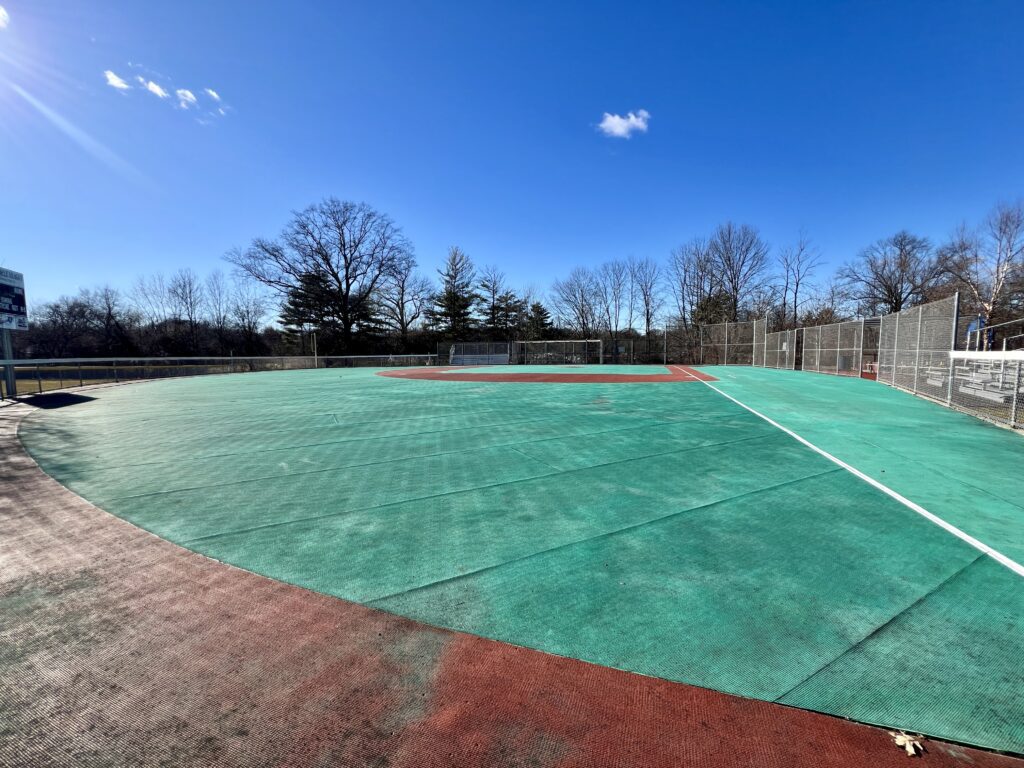
The Miracle League field is in need of resurfacing. Photo credit: Ronni Newton
The field opened in 2012, and the warrantee was seven years. “It’s time. It’s overdue by a couple of years,” Michaud said.
A spokesperson for the developer did not provide specific details but said last week that “they are actively working on a solution.”
The resurfacing can only be done in the summer, because the temperature overnight must remain above 50 degrees. It’s already too late to schedule the work for 2024, but Michaud is hopeful the work can be done after the spring baseball season of 2025.
Like what you see here? Click here to subscribe to We-Ha’s newsletter so you’ll always be in the know about what’s happening in West Hartford! Click the blue button below to become a supporter of We-Ha.com and our efforts to continue producing quality journalism.


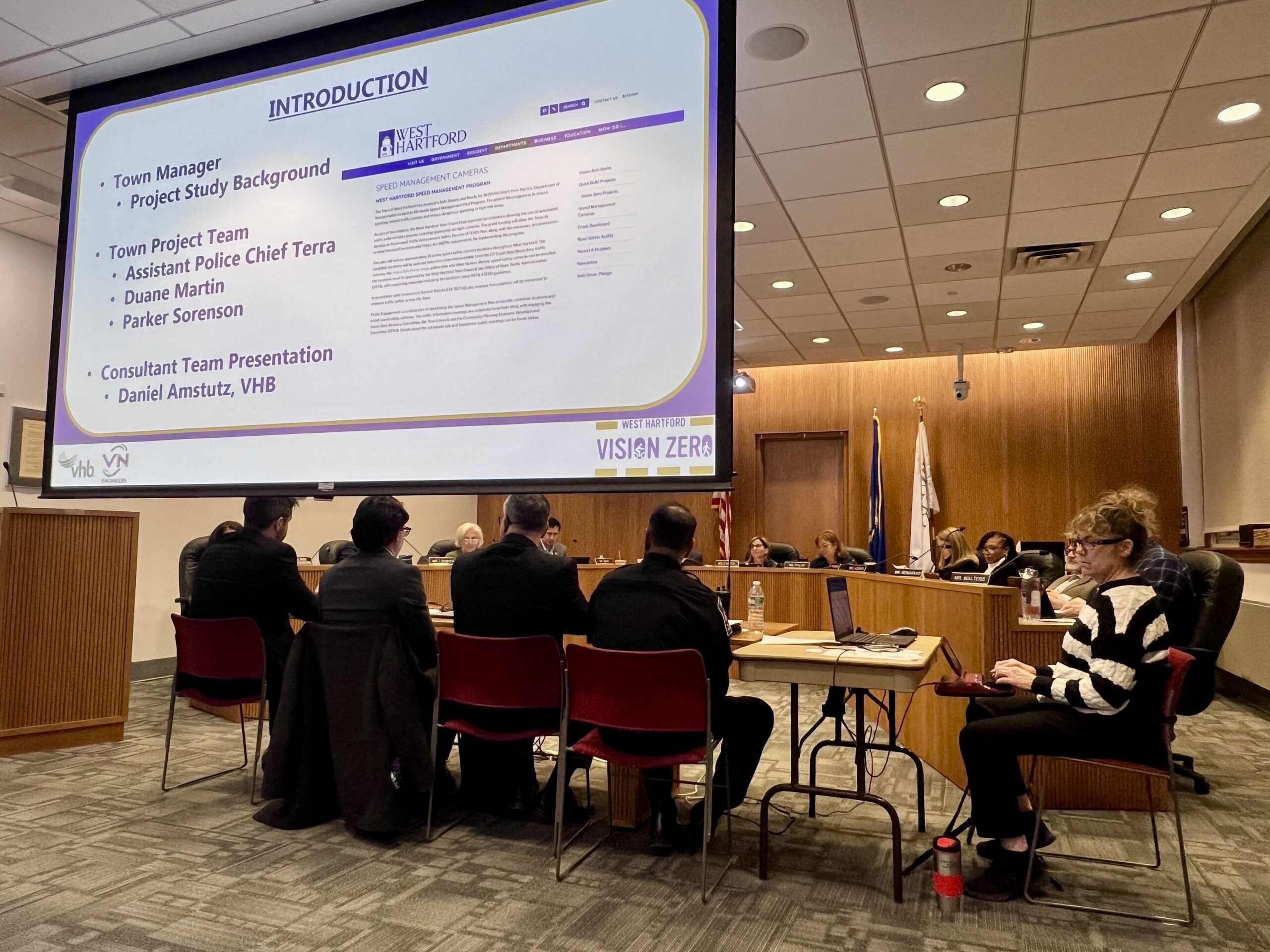

[…] week will by a busy Town Council week with the hearing tonight at 5:30 p.m. on the application for a zoning change and creation of a special develo… – the eastern portion of the former UConn campus. Tuesday night is a regular Town Council […]
[…] also expressed concern about the lack of a long-term lease for the property, which is important because the Miracle League field is in need of replacement and while […]